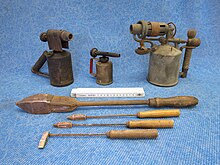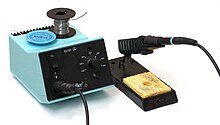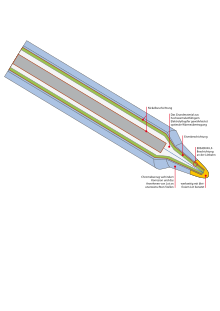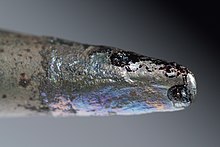soldering iron
The soldering iron is a device used to connect components by hand by soldering .
When soldering with a soldering iron (hand soldering), metal parts and another, low-melting metal (the solder , e.g. solder ) are heated and the metal parts that are brought together are wetted by the solder and are then connected electrically and, after cooling, also mechanically. A flux is required as an auxiliary substance for hand soldering .
Soldering irons are only used for soft soldering . Brazing with copper tips is not possible. Gas flames or lasers are also used for this purpose, but also for soft soldering.
Types
There are known electric and fire-heated soldering irons. The latter use gas or coal.
Fire heated soldering irons
Early soldering irons often have a hammer shape and consist of a 250 to 1500 g copper block with an iron handle (poor heat conduction) and a wooden handle. The copper block usually has a cutting edge or fin, which enables the finer application of heat and solder. Pointed pistons were used for even finer work (in the picture: 3rd vo). The piston is heated with a blowtorch, whereby the copper blackens and then becomes bright again in the flame. The copper block has enough heat capacity to process larger solder joints.
Coal basins were also used in the construction of telecommunications engineering lines. They were about the size of a shoebox and were fired with fat or charcoal. Heat-insulated handles (mostly wood) allowed transport in the company. Such braziers were common for soldering prior to the invention of the blowtorch. There was a particular risk of fire when working on roofs; if handled carelessly, the roof structure could catch fire .
These old soldering irons, like other large soldering irons, were regularly cleaned by rubbing on an ammonia stone during operation .
Soldering water ( zinc chloride solution with excess hydrochloric acid ) was used to clean the solder joint .
As flux served rosin and solder flux . In the area of water installations, stearin , usually in the form of a candle, was also used to solder lead pipes .
If the tin no longer flows, it has to be reheated. Gas-heated soldering irons were later developed in which a gas flame continuously heats the copper block.
Electric soldering iron
An electric soldering iron consists of a mostly exchangeable soldering tip and a heating element ( heating coil or PTC thermistor ).
In simple models, the heating element encloses the soldering tip made of copper and cylindrical on the shaft. Such soldering tips oxidize in the unwetted part and alloy off in the area wetted by the solder. They are therefore interchangeable and, if necessary, trimmed (tapping, filing, brushing) in order to remain operational. Later they went over to making the soldering tips hollow and provided with a permanent protective layer (permanent soldering tip). In these models, the heating element is cylindrical and is located inside the soldering tip.
Power is supplied directly from the mains or with low voltage supplied by a mains transformer .
With temperature-controlled soldering irons, the heating is controlled in such a way that a target temperature is maintained. The temperature is either measured with an additional temperature sensor mounted as close as possible to the tip (controller in the supply part), or the temperature-dependent electrical resistance of the heating wire is evaluated to determine the temperature. Temperature controlled soldering irons are particularly useful for soldering temperature sensitive electronic components.
Self-regulating heating elements have a markedly steep increase in specific electrical resistance in the soldering temperature range; they are made of cold conductive material. After reaching the characteristic temperature, almost no current flows through them. When the temperature drops, the current increases immediately.
In the case of electromechanically temperature-controlled soldering irons, some models (e.g. Magnastat from Weller ) have an element made of ferromagnetic material on the soldering tip: if the soldering tip is cold, the element attracts a movable magnet that switches on the heating current. When the cap reaches its Curie temperature , the magnet is no longer attracted, springs back into its rest position and the heating is switched off again. The Curie temperature is a fixed, aging-resistant property of the cap material, which is permanently preset by its alloy.
Electric soldering irons are available, depending on the area of application , with heating outputs from around six watts (“soldering needle”) (micro soldering iron) up to several hundred watts. Temperature-controlled soldering stations are often suitable for both fine and rough work.
The electric soldering iron was invented by the German engineer Ernst Sachs at the Technikum Mittweida , who received a patent for it on July 8, 1921 .
Soldering gun
Another type of electrical soldering device is the soldering gun named after its typical shape (see picture). Your heating coil shortened to a loop is used as a soldering tip itself. In contrast to an electric soldering iron, the soldering tip is itself traversed by the current. Due to the shape of the soldering tip (a rather short, thick conductor), a high current at a low voltage is required. That requires thick cables. In order to keep this short, the transformer required for voltage conversion and electrical isolation from the lighting network is integrated into the device. Due to the pistol shape, the soldering device remains manageable despite its comparatively high weight and volume.
Compared to soldering irons, soldering guns have a relatively short heating-up time of just a few seconds. They are therefore only switched on for the soldering process by a button located in the handle. The devices are not suitable for continuous operation. Soldering work with soldering guns is only possible to a limited extent because, on the one hand, the point cannot be very pointed due to the principle and, on the other hand, there is no great heat output or heat capacity available for coarser work.
Soldering tip
Soldering tips are made of copper. This is alloyed with tin, d. H. the soldering tip dissolves in the tin, it becomes pitted and has to be filed down. Lead-free solder dissolves copper tips faster than lead-containing solder.
A so-called permanent soldering tip consists of a copper core for heat conduction and is galvanically coated with an iron layer. Iron is used because it can be wetted with tin, but it is very slowly deposited in liquid tin. This increases the service life of the tip. The tip is pre-tinned. The non-wettable part is protected against corrosion with a chrome or nickel / chrome layer. If the tip becomes unwettable, a salmiac stone at the highest soldering iron temperature will help. A permanent soldering tip must not be mechanically treated (ground down). This will destroy the iron layer and make the soldering tip unusable.
The type of cleaning depends on the intended use. Soldering tips for electronic components are usually cleaned with a damp sponge. Acidic or other chemically aggressive cleaning agents are not used for such soldering tips.
Oxidation of the shank of copper soldering tips in the heating cartridge may prevent them from being pulled out. This can be remedied by regular brushing and wrapping with a little household aluminum foil.
Soldering tips come in different shapes. For example, round conical and flat tips are common.
application
The soldering iron or hand soldering is mainly used for repair work, for the production of test samples, in the production of small series or by do-it-yourselfers.
Soldering processes such as wave or wave soldering or reflow soldering are used in industrial production . But also in the craft, the time-consuming soldering is in many areas by mechanical connection techniques, such as. B. crimping , press-fit technology , wrapping and various clamping and plugging techniques have been replaced.
To loosen a soldered connection and to remove the binding metal, you usually use a desoldering braid or a desoldering pump together with the soldering iron .
Technical characteristics
The technical characteristics of a soldering iron are its electrical power in watts, the working temperature range, the type of clamp at the end of the iron and the geometry of the soldering tip and the type of holder.
The electrical output of a conventional soldering iron ranges from around 15 to 180 W, the working temperature range is usually between 150 and 480 ° C. The type of solders that can be used depends on this. Soldering tips differ in diameter and can be designed differently in their geometric shape.
Web links
literature
- Reinard J. Klein Wassink: Soft soldering in electronics . 2nd Edition. Eugen G. Leuze, Saulgau 1991, ISBN 3-87480-066-0 .
- Wolfgang Scheel (Hrsg.): Assembly technology of electronics . Verlag Technik et al., Berlin et al. 1997, ISBN 3-341-01100-5 .
Individual evidence
- ↑ Archived copy ( memento of the original dated November 26, 2016 in the Internet Archive ) Info: The archive link was inserted automatically and has not yet been checked. Please check the original and archive link according to the instructions and then remove this notice. Datasheet 180W soldering iron






